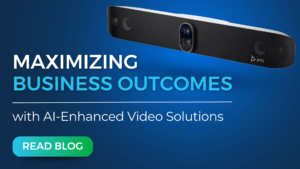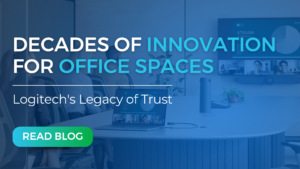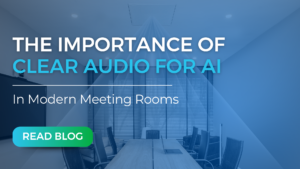Building Workspaces That Empower Every Type of Collaboration

As work environments evolve, building workspaces that meet diverse needs has become essential for modern productivity. No longer limited to traditional conference rooms, today’s workplaces benefit from a variety of specialized spaces—each designed to enhance productivity, creativity, and flexibility. When choosing the right technology and configurations for these spaces, it’s essential to match each area with its intended purpose, whether it’s a quick brainstorming session, a formal client presentation, or focused individual work. Here’s how to strategically plan your workspaces to meet the diverse needs of your team.
Why Creating a Variety of Workspaces Matters
Modern workplaces are dynamic, with employees who might alternate between collaborative and focused tasks throughout the day. Designing specific areas for these tasks allows your team to move fluidly between individual and group activities, supporting productivity and morale. With the right mix of space types, you can create an environment that not only optimizes workflow but also promotes employee satisfaction by giving them a choice of where and how they work.
Research shows that offering a variety of workspaces—from private desks to communal areas—empowers employees to work in ways that best suit their tasks and work styles. Flexible workspaces also foster innovation by encouraging spontaneous interaction and collaboration. When you align your technology and space planning with these needs, you create a more effective, adaptable work environment.
Types of Workspaces and Their Technology Needs
Building Workspaces for Focused Tasks: Personal Workspaces
While collaboration is critical, focused individual work remains a core part of daily operations. Personal workstations should be equipped with ergonomic furniture and high-quality tech accessories, such as noise-canceling headsets and monitors. For remote or hybrid teams, consider adding portable tools, like wireless keyboards and webcams, that allow employees to seamlessly transition between in-office and remote work.
- Key Technologies: Ergonomic furniture, docking stations, monitors, headsets, webcams.
- Best For: Independent, focused tasks, video calls, and ongoing project work.
Building Collaborative Workspaces: Huddle Rooms
Huddle rooms provide a private space for small teams to collaborate on short-term projects or spontaneous brainstorming sessions. These areas benefit from simplified video conferencing and screen-sharing technology to enable efficient collaboration in real time. Keep these spaces agile and equipped with easy-to-use AV tools so that small teams can jump in, connect quickly, and start working without setup delays.
- Key Technologies: Compact video conferencing systems, interactive displays, wireless sharing solutions.
- Best For: Brainstorming sessions, project check-ins, small meetings, and impromptu discussions.
Building Workspaces for Formal Meetings: Medium to Large Conference Rooms
Conference rooms continue to play an essential role for formal meetings, presentations, and client interactions. When building these workspaces, invest in high-quality video conferencing systems, microphones, and smart boards to ensure clear audio and video quality. With the rise of hybrid work, advanced AI features—like speaker tracking and smart framing—keep remote participants engaged by focusing on the active speaker or automatically framing groups.
- Key Technologies: AI-enabled cameras, ceiling microphones, large displays, smart boards, room scheduling software.
- Best For: Formal presentations, larger team meetings, and client calls where professionalism and clarity are paramount.
Hot Desking and Shared Workstations for Hybrid Flexibility
With hybrid work models on the rise, hot-desking setups provide flexibility for employees who work on-site part-time. These shared workstations should be equipped with plug-and-play technology, allowing employees to quickly connect their devices and get to work. Consider integrating hot-desking with a reservation system so employees can easily book spaces in advance, avoiding scheduling conflicts and maximizing resource use.
- Key Technologies: Universal docking stations, wireless charging, reservation and scheduling software, monitors.
- Best For: Hybrid employees, visiting team members, and shared use by multiple teams.
Specialized Collaboration Areas for Creative and Technical Work
Innovation labs, training rooms, and design studios are designed for specialized tasks that may require unique equipment. For example, an innovation lab might be equipped with interactive displays and smart whiteboards for creative brainstorming, while a training room might need AV equipment and presentation software for educational sessions. These areas should be customized to support the specific needs of the team members who use them.
- Key Technologies: Smart whiteboards, interactive displays, specialized AV setups, creative software.
- Best For: Intensive brainstorming, technical training, and immersive creative sessions.
Matching Technology to the Purpose of Each Space
When building workspaces, select technology that aligns with its purpose to avoid overspending on features that aren’t needed and underestimating needs in critical areas. Here are some guiding principles to keep in mind when aligning technology with workspace types:
Understand User Needs: Involve employees in the planning process to gain insights into their workflow needs, preferred meeting formats, and collaboration styles. For example, teams working on complex projects might need interactive displays in huddle rooms, while hybrid teams could benefit from high-quality conferencing equipment in shared spaces.
Invest in Adaptable Technology: With technology evolving rapidly, invest in solutions that offer firmware updates or modular designs. This allows you to add or upgrade features over time without having to completely replace equipment, maximizing the return on your technology investment.
Prioritize Interoperability and Ease of Use: Choose technologies that work across various platforms and devices. In a hybrid work environment, tools that can seamlessly integrate with multiple operating systems make transitions smoother and reduce compatibility issues.
Leverage Analytics for Space Usage: Consider integrating workplace analytics software to monitor space usage and identify which areas are frequently occupied or underutilized. This data helps you make informed decisions about space allocation, ensuring that high-demand areas are adequately equipped.
Creating an Adaptable Workspace for the Future
A well-designed workspace isn’t just about the present; it’s about being adaptable to future needs. Investing in modular technology and multi-use spaces can reduce the need for frequent upgrades and keep your workplace current. As your organization grows or shifts to new work models, having flexible, adaptable workspaces ensures that you can make seamless transitions without disrupting productivity.
With The UC Advantage, UnifiedCommunications helps you assess and implement the right solutions for your unique environment. Our partnerships with top brands, combined with our expertise in AV solutions and workspace optimization, make us a trusted resource for businesses looking to create efficient, collaborative spaces that are ready for what’s next.
Final Thoughts
Selecting the right solutions for your business is about more than just choosing the latest tech. It’s about building workspaces that empower your team to work effectively in any setting. At UnifiedCommunications, we’re here to support your vision with solutions tailored to your specific needs, whether it’s designing huddle rooms for brainstorming, outfitting conference rooms for client presentations, or setting up flexible workstations for hybrid employees.
Get Started with a Consultation
Contact us today for a complimentary technology consultation with a UnifiedCommunications Strategist. Together, we’ll create a workspace plan that aligns with your goals, meets your team’s needs, and maximizes the value of your technology investments.



